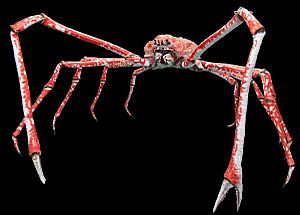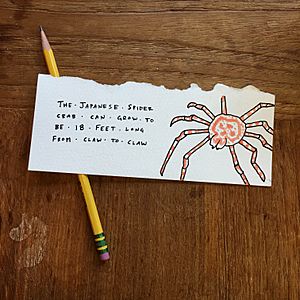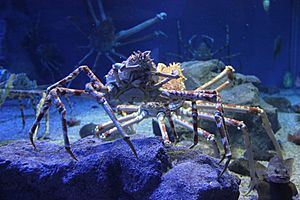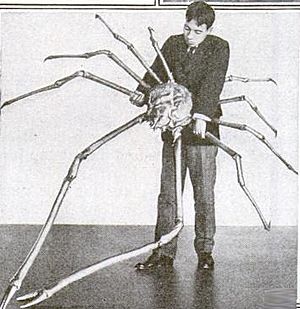Japanese spider crab facts for kids
Quick facts for kids Japanese spider crab |
|
|---|---|
 |
|
| Scientific classification | |
| Kingdom: | |
| Phylum: | |
| Subphylum: | |
| Class: | |
| Order: | |
| Infraorder: | |
| Superfamily: | |
| Family: |
Inachidae
|
| Genus: |
Macrocheira
|
| Species: |
M. kaempferi
|
The Japanese spider crab (Macrocheira kaempferi) is a special type of ocean crab. It is the only member of its genus called Macrocheira. You can only find this amazing crab in the waters around Japan.
This crab is famous for having the longest legs of any arthropod (a group of animals with exoskeletons, like insects and spiders) in the world! Its legs can stretch up to 3.8 meters (12 feet) long. That's longer than a small car! It can also weigh up to 41 pounds (19 kg). People in Japan sometimes catch these crabs for food, as they are considered a special dish.
Contents
What Does the Japanese Spider Crab Look Like?
The Japanese spider crab has the longest leg span of any arthropod on Earth. Its legs can reach up to 3.8 meters (12 feet) across. Even though its legs are super long, its main body is only about 15 inches long.
This crab has eight long legs for walking. It also has two special arms that it uses for finding and eating food. Each of these feeding arms can be about 1.5 meters (5 feet) long! The crab is usually orange with white spots on its legs. Even though it looks a bit scary, this crab is actually known to be very gentle.
Its hard outer shell, called an exoskeleton, helps protect it from bigger ocean animals like octopuses. Japanese spider crabs also use a clever trick to hide. Their bumpy shell helps them blend in with the rocky ocean floor. To hide even better, they often put sponges and other small sea creatures on their shells. This makes them look like part of the seabed.
Where Do Japanese Spider Crabs Live?
You can find the Japanese spider crab in the Pacific Ocean near the Japanese islands of Honshu and Kyushu. They often live in places like the Sagami, Suruga, and Tosa bays. They are also found off the coast of the Kii peninsula.
These crabs usually live in very deep parts of the ocean. They can be found at depths up to 750 meters (2,500 feet). That's deeper than many tall buildings! Once, a Japanese spider crab was found far south in Taiwan. However, this was probably a rare event. It might have been carried there by a fishing trawler or very strong ocean currents.
What Do Japanese Spider Crabs Eat?
The Japanese spider crab is an omnivore. This means it eats both plants and animals. It also acts like a clean-up crew in the ocean. It often eats dead animals that have sunk to the ocean floor.
Some spider crabs like to scrape the ocean floor to find plants and algae to eat. Others are strong enough to open the shells of mollusks, like clams, to get to the soft animals inside.
Japanese Spider Crab Life Cycle
Female crabs carry their fertilized eggs attached to their bodies. They hold onto these eggs until they are ready to hatch. When they hatch, the baby crabs are tiny and float in the water as plankton.
A female crab can lay a lot of eggs, sometimes up to 1.5 million eggs in one season! These eggs usually hatch in about 10 days.
Fishing and Protecting the Japanese Spider Crab
Fishermen usually catch these crabs using small nets called trawling nets. In recent years, the number of Japanese spider crabs has gone down. This is partly because of too much fishing, which is called overfishing. Because of this, fishermen now have to go into deeper waters to find them. The crabs that are usually caught have a leg span of about 1.0 to 1.2 meters (3.3 to 3.9 feet).
Many people are working hard to protect these amazing crabs. One way they are trying to help is by releasing young crabs that were raised in special facilities back into the ocean. This helps to increase the wild population.
Also, there are special laws in Japan to protect the crabs. From January to April, fishermen are not allowed to catch spider crabs. This is their typical mating season, and during this time, they move to shallower waters where they are easier to catch. This rule helps the crabs reproduce and allows young crabs to grow bigger before they can be caught.
Adaptations
The Japanese spider crab has developed a number of remarkable adaptations that allow it to thrive in its deep-sea environment.
Physical and Anatomical Adaptations
- Their extremely long legs allow them to cover a large area on the soft, muddy seafloor without sinking. They act like snowshoes, distributing the crab's weight. These long legs are also excellent for slowly scavenging a wide territory for food.
- Their carapace (shell) is often covered in spines and hooks. They are masters of "decorator crab" behavior, attaching sponges, algae, and other marine organisms to these hooks. This provides incredible camouflage against predators like octopuses and large fish, making them look like a messy, uninteresting part of the seafloor.
- Like all arthropods, they must molt (shed their hard shell) to grow. This allows them to regenerate lost limbs. If a predator catches a leg, the crab can simply detach it (a process called autotomy) and grow a new one over several molts.
- They live at depths of 160 to 2,000 feet (50 - 600 meters). This deep, cold environment is relatively stable and has fewer large predators than shallower waters. Their bodies are adapted to withstand the cooler temperatures and higher pressure.
Behavioral and Physiological Adaptations
- They are not active hunters. Their primary strategy is to slowly walk the seafloor, using their long legs to feel for and gather anything edible. They consume dead animals (carrion), decaying matter, shellfish, algae, and even plants. This low-energy feeding strategy is perfect for an animal with a slow metabolism.
- They are believed to live for up to 100 years. A long lifespan allows for a slow reproductive cycle and reduces the pressure to rapidly repopulate. They can take their time to grow and reach maturity.
- During the spring mating season, adults undertake a vertical migration to shallower waters (around 50 meters). The warmer waters in the shallows are ideal for the development of the female's eggs once they are fertilized. After breeding, they return to the depths.
Images for kids
-
Rear view of a Japanese spider crab at Monterey Bay Aquarium
See also
 In Spanish: Cangrejo gigante japonés para niños
In Spanish: Cangrejo gigante japonés para niños






